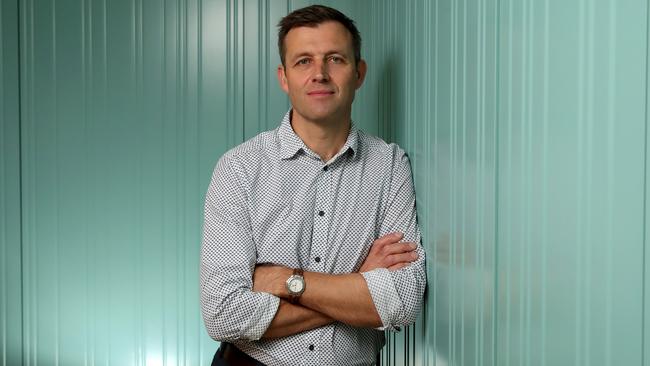IFM puts infrastructure on green path with 40pc lower carbon emissions target
IFM Investors chief executive David Neal reckons the $174bn fund is leading the way in decarbonising its infrastructure portfolio.

Business
Don't miss out on the headlines from Business. Followed categories will be added to My News.
IFM Investors has set a target of 40 per cent lower carbon emissions for its key infrastructure portfolio by 2030, laying the groundwork for the entire $174bn fund to achieve net zero emissions by 2050.
The transition target, which uses the comparative emissions level in 2019 as its base, will be adjusted annually for divestments and investments.
IFM, which is a major investor for industry super funds, has also changed its investment decision-making processes to help ensure that new acquisitions are aligned with net zero by 2050.
New acquisitions would therefore consider climate change transition and physical risks under specific reference scenarios, including a 1.5C limit on global warming.
IFM chief executive David Neal said he liked to think that IFM was “leading the way” in decarbonising its infrastructure portfolio.
“These are long-term essential services that we’re overseeing, and many of them have quite challenging emissions footprints and are difficult to grapple with,” Mr Neal told The Australian.
“We want to encourage others and be encouraged by others because we’re all on the same journey.”
For IFM, it was vital to have a plan to mitigate the risks of climate change so that the fund could deliver on its purpose to protect and grow the long-term retirement savings of working people.
The fund was confident, he said, that the measures put in place for the infrastructure portfolio were “real, achievable and in the best interests of investors, their members and beneficiaries”.
IFM, which is owned by 27 not-for-profit industry superannuation funds, invests in four asset classes: infrastructure, listed equities, debt and private equity.
Among the assets in the $75bn infrastructure portfolio are ownership stakes in Melbourne Airport, Anglian Water and Manchester Airports Group in Britain, US pipeline operator Buckeye and renewable energy investment platform Nala.
IFM prioritises the interests of more than 500 like-minded investors around the world, and as a signatory to the United Nations-supported Principles for Responsible Investments, actively engages on ESG (environmental, social and governance) issues with the companies in which it invests to lift performance and minimise risk.
Last year, the fund set a net zero by 2050 target across its asset classes.
To help meet the commitment, IFM established a task force to identify how each asset class would contribute.
The program of work led to the Scope 1 and Scope 2 emissions reduction target of more than one million tonnes of carbon dioxide in the infrastructure portfolio by 2030, announced on Monday.
Scope 1 covers direct emissions from owned or controlled sources, while Scope 2 involves indirect emissions from the generation of purchased electricity.
With asset management, IFM said climate change transition and physical risks would be assessed on a “periodic basis”, using reference scenarios also including the 1.5C limit.
Emission-reduction initiatives would be implemented for infrastructure assets, and exposure to thermal coal would be phased out by 2030.
No new investments would be made in assets deriving more than 20 per cent of their revenue from thermal coal.
In the meantime, “significant” investment opportunities would also arise in the energy transition, in which the fund would continue to participate.
IFM said carbon reduction initiatives in its infrastructure portfolio included a recently completed on-site solar farm at Melbourne Airport, which was expected to generate up to 15 per cent of the asset’s annual electricity consumption – enough to power all four terminals.
The renewable energy generated would prevent up to 15,300 tonnes of carbon emissions from entering the atmosphere.
Anglian Water, meanwhile, generated 131.1 GWh from renewables in 2020, which is enough to power 40,000 homes for a year, and Buckeye recently announced strategic investments in renewable and low-carbon opportunities.
With Nala, IFM and Trafigura formed a joint venture in 2020 to invest in wind, solar and energy storage projects worldwide.
IFM said further work was being undertaken on how its non-infrastructure asset classes would meet the group’s net zero commitments, and would form part of an overarching climate change strategy to be released in the coming months.
Global head of infrastructure Kyle Mangini said IFM was making infrastructure investments today that its investors expected to hold for the long term.
“If these investments are to generate strong, long-term sustainable returns, we need to ensure that they continue to play an important role in society in a net zero economy,” Mr Mangini said.
“We look forward to continuing to work closely with our investee companies as we embrace the energy transition together.”
While it was easier to get a renewables project off the ground, Mr Mangini said there was nowhere near the level of consolidation in renewables as there was in the fossil fuel industry.
Also, no single renewables business came anywhere the size or scale of the fossil fuel giants.
“The investment shift to renewables is happening but it’s just start to rev up,” he said.
More Coverage
Originally published as IFM puts infrastructure on green path with 40pc lower carbon emissions target





